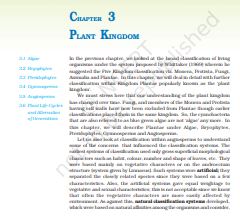‘NCERT Solutions for Class 11 Biology Chapter 3‘ PDF Quick download link is given at the bottom of this article. You can see the PDF demo, size of the PDF, page numbers, and direct download Free PDF of ‘Ncert Class 11 Biology Chapter 3 Exercise Solution’ using the download button.
NCERT Class 11 Biology Textbook Chapter 3 With Answer PDF Free Download

Chapter 3: Plant Kingdom
We must stress here that our understanding of the plant kingdom has changed over time.
Fungi and members of the Monera and Protista having cell walls have now been excluded from Plantae though earlier classifications placed them in the same kingdom.
So, the cyanobacteria that are also referred to as blue-green algae are not ‘algae’ anymore.
In this chapter, we will describe Plantae under Algae, Bryophytes, Pteridophytes, Gymnosperms, and Angiosperms.
Let us also look at classification within angiosperms to understand some of the concerns that influenced the classification systems.
The earliest systems of classification used only gross superficial morphological characters such as habit, color, number, the shape of leaves, etc.
They were based mainly on vegetative characters or on the androecium structure (system given by Linnaeus).
Such systems were artificial; they separated the closely related species since they were based on a few characteristics.
Also, the artificial systems gave equal weightage to vegetative and sexual characteristics; this is not acceptable since we know that often the vegetative characters are more easily affected by
the environment.
Against this, natural classification systems developed, which were based on natural affinities among the organisms and consider. not only the external features but also internal features, like ultrastructure, anatomy, embryology, and phytochemistry.
Such a classification for flowering plants was given by George Bentham and Joseph Dalton Hooker.
At present phylogenetic classification systems based on evolutionary relationships between the various organisms are acceptable.
This assumes that organisms belonging to the same taxa have a common ancestor.
We now use information from many other sources too to help resolve difficulties in classification. These become more important when there is no supporting fossil evidence.
Numerical Taxonomy which is now easily carried out using computers is based on all observable
characteristics.
Numbers and codes are assigned to all the characters and the data are then processed.
In this way, each character is given equal importance and at the same time, hundreds of characters can be considered.
Cytotaxonomy is based on cytological information like chromosome number, structure, behavior, and chemotaxonomy that uses the chemical constituents of the plant to resolve confusion is also used by taxonomists these days.
| Author | NCERT |
| Language | English |
| No. of Pages | 17 |
| PDF Size | 4.7 MB |
| Category | Biology |
| Source/Credits | ncert.nic.in |
NCERT Solutions Class 11 Biology Chapter 3 Plant Kingdom
2. When and where does reduction division take place in the life cycle of a liverwort, a moss, a fern, a gymnosperm, and an angiosperm?
Solution:
The reduction division takes place in the following stages:
(i) Liverworts – meiosis takes place in the spore mother cells of the capsule in sporangium resulting in haploid spore formation
(ii) Moss–meiosis occurs in spore mother cells of spore sacs in the capsule of the sporangium.
(iii) Fern – sporangia are endured on sporophylls (fertile leaves). The process of meiosis occurs in spore mother cells of sporangium for the formation of haploid spores.
(iv) Gymnosperm–meiosis occurs in microsporangia located in the microsporophylls, in the microspore mother cells for the formation of haploid pollen grains giving rise to the male gametophyte
(iv) Angiosperm – pollen grains that are formed in microspore mother cells lead to the formation of male gametophyte in the anther of the stamen. The megaspore mother cell located in the nucleus of the ovule undergoes meiosis for the formation of haploid megaspore, which eventually forms the female gametophyte.
Plant Kingdom NCERT Textbook With Solutions PDF Free Download
